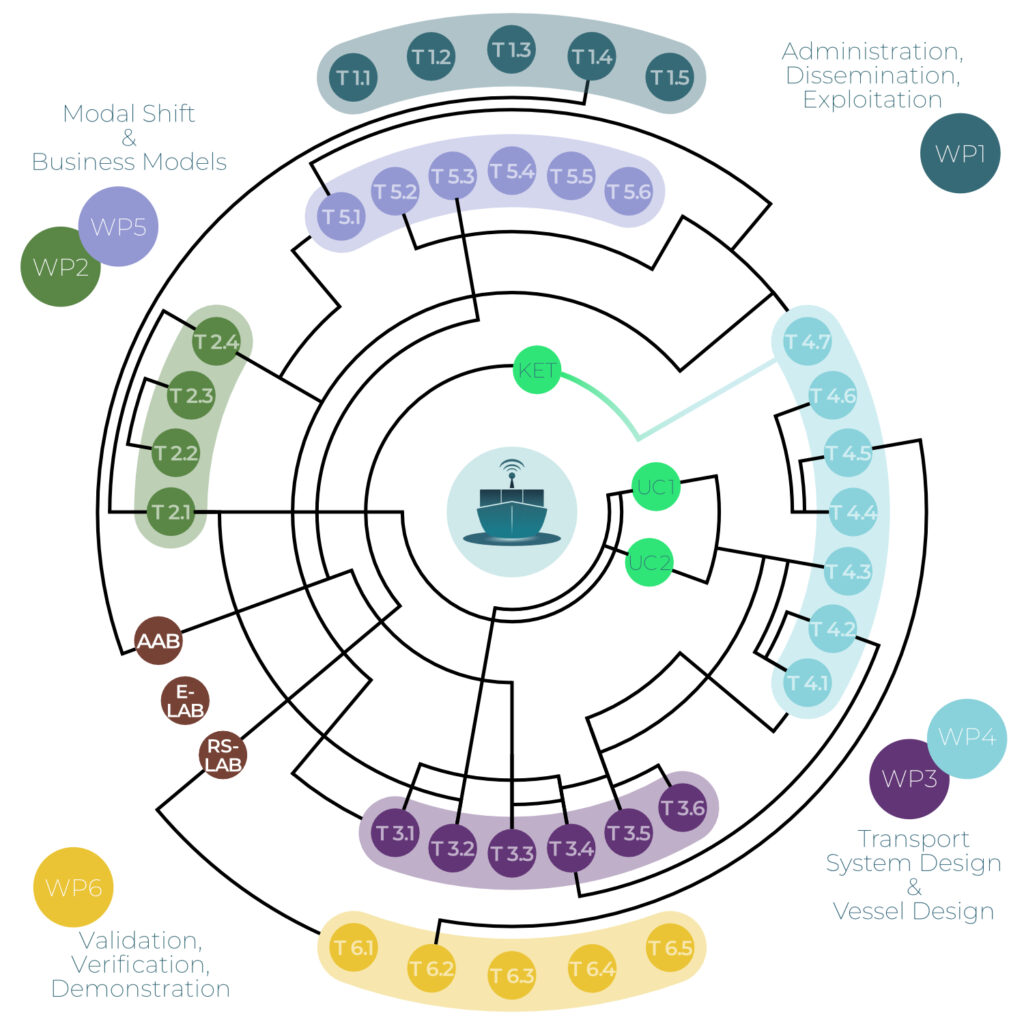Overview on the AUTOFLEX Work Packages
The AUTOFLEX project, funded by the European Union’s Horizon Europe programme, is pioneering the development of autonomous and flexible inland waterway vessels alongside innovative business models aimed at revolutionising the inland waterway transport (IWT) sector. This initiative seeks to facilitate a significant modal shift towards climate-friendly, resilient, and efficient transport modes, thereby contributing to the reduction of road traffic congestion and the associated environmental impacts. The primary goal of AUTOFLEX is to overcome existing barriers to the modal shift by leveraging advanced technologies to create new autonomous inland cargo vessels capable of operating reliably in small waterways, even under challenging conditions such as confined waters and extreme low-water situations. Additionally, the project aims to design new distribution hubs that serve as interfaces to road transport, ensuring seamless cargo transshipment and the provision of zero-emission energy supply for ships and trucks simultaneously.
The project has a duration of three years and nine partners from five countries work, including one associated partner, collaboratively in six work packages. All of which are interlinked and interconnected. Some task depends on the results of others. The content and goals of the work packages are described in the following.
Work Package 1: Project Administration & Dissemination serves as a nexus, interlinking all work packages and partners within the AUTOFLEX project. This package is instrumental in ensuring seamless coordination and management of the project’s administrative, technical, and financial dimensions. Further, guaranteeing adherence to the project timeline and maintaining high-quality standards across all phases. It plays a pivotal role in team building and enhancing consortium synergy, facilitating the collective pursuit of the project’s goals. Additionally, Work Package 1 is responsible for maintaining robust lines of communication with the European Commission, the AUTOFLEX Advisory Board, and external stakeholders, thereby ensuring broad dissemination of project outcomes. The tasks encompassed within this package extend to risk management, the strategic dissemination of findings across public, industry, and academic forums, and the exploitation of results, all aimed at amplifying the impact and benefits for society and the industry at large.
WP2: From Modal Shift Barriers to Design Parameter Quantification deals with understanding and quantifying the design parameters and boundary conditions necessary for the development of the AUTOFLEX transport system. It aims to overcome barriers to the modal shift towards more sustainable transport modes by defining specific requirements and performance targets. This work package encompasses a comprehensive analysis of the transport market to identify key performance indicators (KPIs) for evaluating the AUTOFLEX transport system. It involves modelling and simulating the new transport system based on real-world logistic data and conducting stakeholder interviews to derive mode selection criteria. The insights gained are crucial for laying the foundation for innovative business models and the further development of logistical analysis tools.
WP3: Developing Automated Multimodal Zero-Emission Transport Systems focuses on developing the necessary components to realise efficient, zero-emission transport systems. This includes creating a transport system where truck transport for urban distribution is minimised. The work package explores the development of combined energy and cargo hubs, investigates the feasibility of temporary port terminals for cargo transfer, and conceptualises mobile distribution centres. By re-designing the transport system architecture and implementing the AUTOFLEX system, the project aims to validate the performance, liability, safety, security, and resilience of the transport systems. This work package is instrumental in moving towards zero-emission transport systems by investigating renewable energy supply methods.
WP4: Developing Small Automated Zero-Emission Vessels is dedicated to advancing key enabling technologies (KETs) for uncrewed inland vessels. This involves the hydrodynamic optimisation of vessel power demand and manoeuvrability, structural design using lightweight materials, and the development of a model for estimating the total cost of ownership (TCO) for the vessel concept. Additionally, this work package focuses on creating a catalogue of validation/test cases for automated ship operations and a KPI toolbox for system performance testing. It also addresses the safety monitoring of automated vessel operations and the development of a remote control centre for fleet mission distribution. This comprehensive approach aims to enhance the safety, security, and resilience of automated fleets, contributing significantly to the automation and autonomy of inland navigation.
WP5: Realising the Modal Shift by Sustainable Business Models and Impact Evaluations aims to develop and validate business models required to realise the AUTOFLEX system, demonstrating improved logistical, environmental, and commercial performance. This work package seeks to demonstrate the viability of operating the novel transport system without extensive changes to existing logistic management and Information and Communication Technology (ICT) systems. It involves assessing the applicability of the AUTOFLEX concept in larger waterways during low-water conditions and publishing a white paper with recommendations for policy and investment decision-makers. The development of interface standards for autonomous inland navigation is also a key aspect of this work package, which is crucial for accelerating the uptake of autonomy in the transport sector.
WP6: Demonstration and Validation focuses on the practical application and testing of the technologies developed in the AUTOFLEX project. It involves the verification of power demand and manoeuvrability of small uncrewed vessels through scale model testing and simulations, as well as planning, risk and safety analysis, and obtaining approvals for full-scale demonstrations. This work package is pivotal in verifying automatic navigation capabilities in both scale model tests and full-scale demonstrations, thereby validating the autonomous inland navigation technology developed. The successful completion of WP6 is critical for demonstrating the feasibility and effectiveness of the AUTOFLEX technologies in real-world settings, marking a significant step towards the implementation of automated and zero-emission transport systems in inland waterways.
